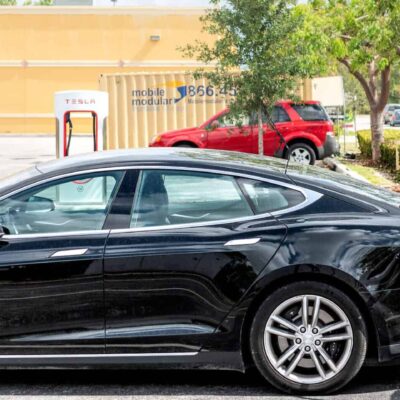Electric vehicle sales are estimated to hit an all-time high at 10.5 million units in 2022, which is up around 4 million from 2021. As the demand for green transportation methods grows, the auto industry has been pushed towards a total technological revolution as we head towards 2030. To support the increased interest from consumers, investors, and manufacturers alike, the government is now faced with implementing and improving EV infrastructure to usher in (and encourage) the shift towards fully or partially electric vehicles.
For Chapter 2 of our WIT On Point EV series, WIT brought together a panel of experts with knowledge on aspects of all things automotive to discuss developments in EV infrastructure and evaluate the electric switch. These professionals have decades of experience working in vehicle design and manufacturing and are active in the electric vehicles industry.
The Experts
WIT’s VP of Operations, Mike Connelly, was joined by Laine Mears, who has over 25 years of experience in automotive manufacturing; Andrea Strzelec, a leading expert in engine systems; and Marcus Gilmore, who has spent over a decade working on sustainable energy systems and has recently focused on green transportation.
Chapter 1 covered the topic of meeting electrification goals- namely, the U.S. goal to have half of all new cars be zero-emission by the start of the next decade. Core to the discussion were viewpoints on what it would take for the U.S. to meet its target.
For this edition, the conversation among our panelists explored the major EV infrastructure challenges currently facing the industry’s players. Concepts covered in the discussion surrounded battery charging methods, zero-emission vehicles, and the trajectory of hybrid vehicles. Read on to learn what the panel feels is in the future for our next generation of fleets.
Charging Innovation and Infrastructure
When powering vehicles in any form, we realize the automotive landscape is made up of a myriad of competing infrastructures. The standards for gasoline, for example, are way more developed than they are for much smaller networks run on electricity, hydrogen, or natural gas. But with these different infrastructures comes a laundry list of challenges brought on by conflicting government and commercial interests. Industry expert Laine Mears feels that this can be mitigated if groups of manufacturers like the IATF come together and work towards a common industry standard. In the future, Laine sees electric vehicles with a standardized battery design. He says, “Rather than sitting there for 30 minutes charging your car, you just pull in, the battery drops out of the bottom, and a fresh one goes in.”
There is a lot that must happen in manufacturing to make that dream a reality. Not only do our cars not have the same battery connectors, but they also do not use the same methods and rates of charging. Some are ready to work off home electronics, and some still need the transformers. Expert Andrea Strzelec claims that because of this, battery differences must be controlled on the vehicle manufacturing side rather than the charger side. As we know, no one wants to sit and wait for their car to charge for 30 minutes. And we’re limited to the amount of these quick charges because of battery degradation. According to Strzelec, the only way we will see more consumer acceptance is if the market changes how long it takes to refuel the vehicle through things like battery swaps. And with this, she says manufacturers are, “Either going to have a cost of retrofitting their legacy vehicles or you’re going to see someone like Tesla trying to dominate and corner the market on the battery design.”
Infrastructure Investments
With the Federal Highway Authority putting out a call for comments on how to spend new infrastructure dollars, we had to ask: are manufacturers going to champion certain areas for funding or will they just flow with where the funds go? Our experts say that they’re going to make their voice heard where it is going to affect their bottom line most. Out of those that will come forward, Mears thinks that a major winner could be bus manufacturers. Proterra Manufacturing, for example, sells electric bus fleets that come with a charging system. Since they act as a complete package, Proterra can help plan the city and the routes, offering a process for how they can make their system work. Mears feels that this model is going to need to be followed by others working towards electrification. Furthermore, the industry needs to consider options like these before money is spent on a system that may not be optimal.
Are We Future-Proof?
As the infrastructure for EV charging becomes more widespread, there has been an influx of announcements from companies claiming that they are going to electrify their fleets. This begs the question: where are we in terms of future-proofing our EV investments? According to industry expert Marcus Gilmore, we aren’t quite there yet. With the exception of a few notable companies, there are still several challenges facing most manufacturers who want to do it at scale. He highlights cost as the biggest barrier; the technology needed to enable 100% electrification of fleets is cost-prohibitive, especially for mass transit and delivery vehicles.
To combat this, companies are looking at other ways to electrify the market. Many are utilizing incentives, and this is a tactic currently being used in programs like one in New York that targets the electrification of medium and heavy-duty fleets. They offer generous incentives for the conversion or replacement of ICE vehicles with electric vehicles, but there’s one caveat: they don’t require the replacements to be fully electric. These programs typically include vehicles that are hybrids or run on solutions like liquefied natural gas, slowing the market’s progression towards an electrified future.
Cost isn’t the only issue when it comes to futureproofing; the supply chain and technology itself present a unique set of problems many manufacturers have yet to find solutions for. When paired with liability issues, these challenges have prevented the smooth switch over that the industry’s players were looking for. So, what can help usher in the shift?
Future of Hybrids and the Existence of Zero-Emissions
In the race to a zero-emission 2030, many are beginning to ask: do zero-emissions vehicles truly exist? According to Strzelec, they do not. In her opinion, a zero-emissions vehicle (ZEV) or partially zero-emissions vehicle (PZEV) is a political designation on tailpipe-only emissions, not truth. EVs have emissions from tie wear, tire dust, and brake dust in addition to the electricity generation needed to power the car. But, if we are looking at a fast implementation of something that will decrease CO2 emissions, she feels that hybrids are the obvious answer as they can work on either powertrain, eliminating the implementation barriers of EV infrastructure.
This, in turn, can affect everything from the creation of green transportation programs to the focus of manufacturers. When it comes to forming incentive programs that encourage a shift to these vehicles, Gilmore says it really depends on the market and the goal. In his experience, the entity spearheading the program typically starts broadly, and then when they reach a certain penetration rate, they incorporate every type of vehicle from battery-electric and plug-in electric to hybrid and hydrogen fuel cell.
Gilmore feels that pre-owned vehicles will play a large role in the market shift. All of the plug-in hybrids that were used to bridge technologies at the start of this movement are still on the market, and they hold great value if you can convert more potential customers that would have purchased a traditional ICE vehicle. Why? Well, some may say that hybrids help eliminate range anxiety as they fit more easily into consumers’ current landscape.
Mixing Up Manufacturing
In enacting any sort of shift, manufacturers must move away from making the same thing they have been doing over time. As Mears said, “From the manufacturing perspective if you’re going to go to a fully electric fleet, you’re going to need to make some investments. And I think companies are doing the smart thing these days just saying ‘We’ve got this old factory that we don’t use anymore. We’re going to wipe the slate clean and we’re going to start over again from there.’ I think it’s both a smart move from a cost perspective and it’s a smart move from an innovation perspective because it allows you to take that opportunity to step back.”
Moving away from ICE vehicles and placing a new focus on hybrid and then electric vehicles are essential. As Mears said, a hybrid vehicle is a nice soft landing for both the manufacturer and the consumer. If manufacturers want to capture the interest and future purchasing power of the market, a move to hybrids may be beneficial in reducing emissions and continuing EV infrastructure improvements.
What’s Next?
Stay tuned for more from this conversation with our top electric vehicles experts. Contact us to request access to the recorded panel discussion of Chapter 2 and follow us on LinkedIn and Twitter to stay up to date on our latest insights. And ICYMI, check out Chapter 1.
Get the full recording of Chapter 2 from our EV Panel Discussion to watch immediately by submitting your contact information.




